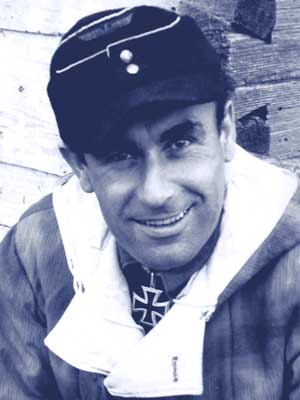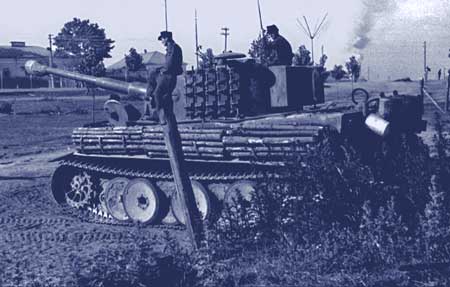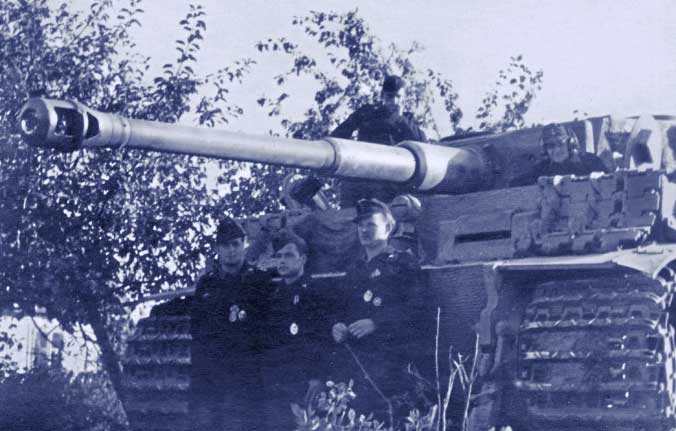During the course of the Second World War, the German Wehrmacht formed a total of fifteen heavy tank battalions (schwere Panzer-Abteilung) equipped with Tiger or King Tiger heavy tanks – twelve for the Heer (Army) and three for the Waffen-SS.
In the decades since the war, a number of excellent memoirs from former Tiger-tank crews have appeared, including Otto Carius’s Tigers in the Mud and Richard von Rosen’s Panzer Ace. Additionaly, several unit histories about the various Tiger-tank battalions have also been published; in particular, J. J. Fedorowicz produced volumes on the combat histories of the 503rd, 507th and 508th Heavy Tank Battalions back in 2000-3.
Helmut Schneider, who edited the earlier volume for Fedorowicz, has now returned with the updated Tiger Battalion 507 by Greenhill. Schneider’s history is a mix of diary entries, veteran accounts and contextual overview, which follow the men of schwere Panzer-Abteilung 507 from the unit’s formation in October 1943 to its eventual dissolution in April 1945.
Schneider’s Tiger Battalion 507 is based on contributions from about a dozen different battalion veterans, mostly compiled in the period 1982-90. Schneider himself was an Unteroffizier (non-commissioned officer) in the battalion in 1943-4, serving as a driver, gunner and briefly as a tank commander. Other veterans who contributed accounts served in a variety of roles, including as tank crewmen and in the workshop (Werkstatt) company.

https://amzn.to/3nxqBU

https://amzn.to/2LDZQ2T
The initial chapter lays out the organisation of the battalion in great detail, including its support elements. By the time that s. Pz. Abt. 507 began forming, the Third Reich was already hard pressed on all fronts and the veterans’ accounts note the chaotic pace at which the battalion was formed in Germany and Holland, then shipped forthwith to the Eastern Front in March 1944.
Tarnopol Ukraine

last commanding officer of Heavy Panzer Battalion 507
The battalion was literally deployed from its rail cars and sent directly into its first battle – the attempted relief of the encircled Tarnopol garrison. The Tarnopol action was fought under extremely adverse conditions, in freezing cold temperatures that made the inside of the Tigers feel ‘just like a refrigerator’.
Nevertheless, the battalion managed to spearhead an advance that pushed through Soviet lines and inflicted heavy losses on the enemy.
However, the German veterans do not mention that the mission ended in failure – the relief effort never reached Tarnopol and the 4,000-man garrison was annihilated. Indeed, like many German veterans’ accounts, the emphasis is placed more on damage inflicted on the enemy, rather than the fact that the Wehrmacht was being steadily pushed back toward the Reich.
The combat accounts and vignettes presented in Tiger Battalion 507 are first-rate and quite candid. One veteran mentions backing his tank up too fast and accidentally running over some German infantry who did not get out of the way in time. Tank versus tank combat is described in fastpaced terms, with enemy shells whizzing by or slamming into the Tiger’s thick armoured hide, while German gunners frantically train their sights on multiple opponents, knocking each out in turn.
Knocking out 136 Soviet tanks
Although many of the crews were quite young, s. Pz. Abt. 507 had a solid core of veterans who held the battalion together and took a terrible toll on the enemy; in one three-day period in January 1945 the battalion was credited with knocking out 136 Soviet tanks.
It is also interesting to see the personal side of war through the eyes of the men in s. Pz. Abt. 507, who linger thoughtfully on comrades killed in action or other small incidents, including some humorous ones. At one point, Schneider was disturbed that a sweater his mother gave him was torn to ribbons by enemy fire. Elsewhere, German tankers are overjoyed to find bacon hidden by peasants – such are the simple joys and frustrations of front-line life.
Tiger tank was relying on rather primitive means to keep it supplied
One of the more intriguing aspects of Tiger Battalion 507 is the emphasis on the maintenance elements. The book has many photos and accounts of repair work in the field, which is not always present in armour unit histories.
Indeed, it is interesting to see from these accounts how frequently the Tigers threw track – either because of soft ground or mines – and the difficulty of track repair on the front line. The Tiger did not perform particularly well on soft ground due to its excessive weight, but the German Army High Command (OKH) apparently disregarded terrain factors when it sent units like s. Pz. Abt. 507 into marshy areas.
Later, in February 1945, a similar disregard for the Tiger’s limitations on crossing water obstacles led to twenty-two Tigers being blown up by their crews, because no provision had been made to get them across the Vistula River. Another aspect mentioned on several occasions is the lengthy time required to refill the Tiger’s 540-litre fuel tank with 20-litre cans; Germany built a very advanced heavy tank but relied on rather primitive means to keep it supplied.
Underground dwellers
By the summer of 1944, s. Pz. Abt. 507 was hard pressed, as the Wehrmacht reeled backward into Poland as a result of the Soviet Bagration offensive. Increasingly, the battalion was not employed as a single formation, but rather operated as single companies in support of different infantry units.
However, once the Eastern Front stabilised later in 1944, the situation changed and the tank crews became ‘underground dwellers’, living in bunkers near their Tiger tanks. Indeed, some crews even had time to help with the harvest and it is clear that the battalion was never short of food or booze.
Attached to one infantry unit, the Tiger crews informed the local commander that they were supposed to receive a daily ration of schnapps – which they got! Compared to other branches of military service, tankers have a well-deserved reputation for seeking out creature comforts, at which the veterans of s. Pz. Abt. 507 were quite adept.

One of the many pictures in the book
Most accounts about the Tiger tank focus on its magnificent 8.8 cm gun and there is plenty of evidence of its lethality presented in Tiger Battalion 507. Although the German tankers were concerned about the new Soviet JS-2 heavy tank, it appears that in most actions involving these vehicles, the Tigers had a distinct edge. The German veterans ascribe the superiority of the Tiger’s gunnery to better training and the fact that the unitary 8.8 cm armour-piercing round could be loaded much quicker than the separateloading (projectile and propellant were separate) ammunition used by the JS-2.
Apocryphal stories
Readers should be aware that old soldiers have a tendency to enlarge on their experiences and some of the veterans of s. Pz. Abt. 507 repeat some rather apocryphal stories, such as a claim that one of their Tigers destroyed a T-34 at a range of 8,000 metres. Such a claim was well beyond what tank sights in 1944 could discern, and even with modern technology the longest tank ‘kill’ on record is ‘only’ 4,700 metres, achieved by a British Challenger tank during the 1991 Gulf War.
On the other hand, the Tiger was continually bedevilled by enemy mines and the Soviets – even when on the offensive – learned to plant mines to thwart German armoured counter-attacks. In one relief action near Brody, the battalion lost five of six Tigers involved to mine damage. While the Tiger was a capable fighting machine, by 1944 it was increasingly operating on its own with limited support from infantry, engineers and artillery, which reduced its overall impact on the battlefield.
Return to Paderborn
By February 1945, s. Pz. Abt. 507 had very few Tigers left and most of the battalion was sent back to Paderborn to re-equip with the King Tiger tank. However, only one company had received its new King Tigers by the time that U.S. armoured units approached Paderborn in late March 1945. A scratch unit was hastily formed, under SS command, and the veterans of s. Pz. Abt. 507 fought their last major action against Task Force Welborn (3rd Armored Division) on 30 March.
The King Tigers inflicted a stinging tactical defeat on the U.S. column but it was irrelevant, since the training station at Paderborn was soon overrun and the battalion itself had essentially ceased to exist by early April 1945. It is noteworthy that the scratch unit formed at Paderborn, lacking maintenance support sub-units, could not operate for very long; many of its King Tigers were lost to minor technical defects.
Camaraderie
Tiger Battalion 507 provides interesting insights into the daily life of German tank crews in 1944-5. In particular, the small-unit camaraderie and skilled leadership really come across as the critical factors which held s. Pz. Abt. 507 together, despite it operating under heavy enemy pressure and a deteriorating wartime situation.
Although, as in most German post-war accounts, the authors try to avoid including any political viewpoints, it is clear that these veterans felt a great deal of pride in both their wartime service and their battalion’s reputation. Schneider manages to sneak a passing reference to fighting ‘for a supposed good cause’ into his introduction, but otherwise there is little mention of the regime that s. Pz. Abt. 507 was fighting to preserve. While post-war accounts such as Tiger Battalion 507 are important for assembling these first-person records before these veterans passed away, it is also important to remember that much of what is related in the book offers a somewhat ‘sanitised’ view of events, in order not to disturb modern sensibilities or impugn any members of the battalion.
Oddly, there is no real mention of military misconduct or even desertions, although some of that must have been going on in the last few weeks of the war, particularly when it was evident that the war was lost and the unit virtually disintegrated. Truth, as often in historical narrative, can remain an elusive quantity.
Robert Forczyk.
Tiger Battalion 507 a preface by Helmuth Schneider
This is the story of Heavy Panzer (Tiger) Battalion 507, a military unit which existed for 500 days until its dissolution just before the Third Reich capitulated. What motivated a number of its former members to club together and commit their experiences to paper after so many years?
One of the reasons is that although Panzer Battalion 507 received mention in the third edition of Tiger — die Geschichte einer legendären Waffe 1942-1945 by Egon Kleine and Volkmar Kühn (pages 294-9), its treatment in comparison with nearly all the other battalions was meagre because the two authors had so little material available. In a letter dated 4 February 1974, the first commanding officer of 507, Major Erich Schmidt (d. 1977) had provided Egon Kleine with some information about his Tiger battalion, but this had not been enlarged on by the time the third edition of that book was published.
The Gathering
Contacts pursued between the years 1977 and 1982 led to more and more former 507 men coming forward from the anonymity of post-war life. After a number of meetings held primarily by 2nd Panzer Division and Panzer Regiment 4 veterans, the first major reunion of former 507 panzer men was held at Rohrdorf/Inntal where it was decided to set up an editorial team to work at expanding the existing material on Panzer Battalion 507.
Leading this team were former Leutnant Dr Hans Maul and Captain (Reserve) Wolf Koltermann, the latter having made great efforts to set up a ‘gathering of former members’, especially from his 3rd Company. His circulars, and lists of names compiled from memory and sent by Kurt Kramer and Heinz Zinke much earlier from Russian captivity, led to a growing number of former comrades-in-arms becoming identified and located, and these then swelled attendances at the biannual reunions.
Putting together the Jigsaw
Meanwhile I, Helmut Schneider, had made a point of writing to all known former colleagues for the purpose of keeping us united and if possible enlarging our numbers; also to stimulate our powers of recall. Thus in later years the jigsaw was gradually put together with photographs, diary entries, letters, battlefield attestations and certificates accompanying the award of badges, medals and decorations, Soldbuch entries, leave passes, wartime newspaper cuttings, Wehrmacht bulletins and naturally accounts of personal experiences. Post-war literature was also used to prompt memories.
‘May the army of millions of dead of all nations bear witness to humanity for the hope that future generations may learn to discard war as the best way to resolve their differences.’
Helmut Schneider
During the nine years which passed since our resolution in 1982 to write the ‘507’ story, very many of our comrades-in-arms have left us for ever, amongst them our editor-in-chief Dr Hans Maul. The fact that all sources of recall had run dry spurred us to proceed on the basis of what we had, and in 1990 the ‘Göttingen editorial team’ confirmed that decision.
What individual authors had contributed in the form of diary extracts, personal experiences and aphorisms had to be assembled chronologically as soon as possible. Because the battalion had never been deployed as a single force, it was clear that reports from front-line companies, staff company platoons, the workshop company, the repairs staffs and the supply unit would all come from a totally different perspective.
Blood brotherhood
Even the five men sitting in the same panzer perceived or were affected by any event differently, and as for being certain of the geographical location, nobody ever kept a large-scale map of the area in which he was spending every day and night for weeks under the most unfavourable conditions!
This book sticks to retelling what our ‘blood brotherhood’ honestly experienced. It is meant to be a record for posterity, but above all a memorial for those comrades-in-arms who in faithful fulfilment of duty laid down their lives for a supposed good cause. Since the personal accounts are not confined to describing only what happened on the battlefield, but also other occurrences and impressions, not least the confusion of retreat, panic-stricken flight and captivity, it is also, so to speak, a collection of ‘partial autobiographies’ of a generation which sacrificed its best years to the war.
May the army of millions of dead of all nations bear witness to humanity for the hope that future generations may learn to discard war as the best way to resolve their differences.
Helmut Schneider
An excellent read! Tiger Battalion 507: Eyewitness Accounts





